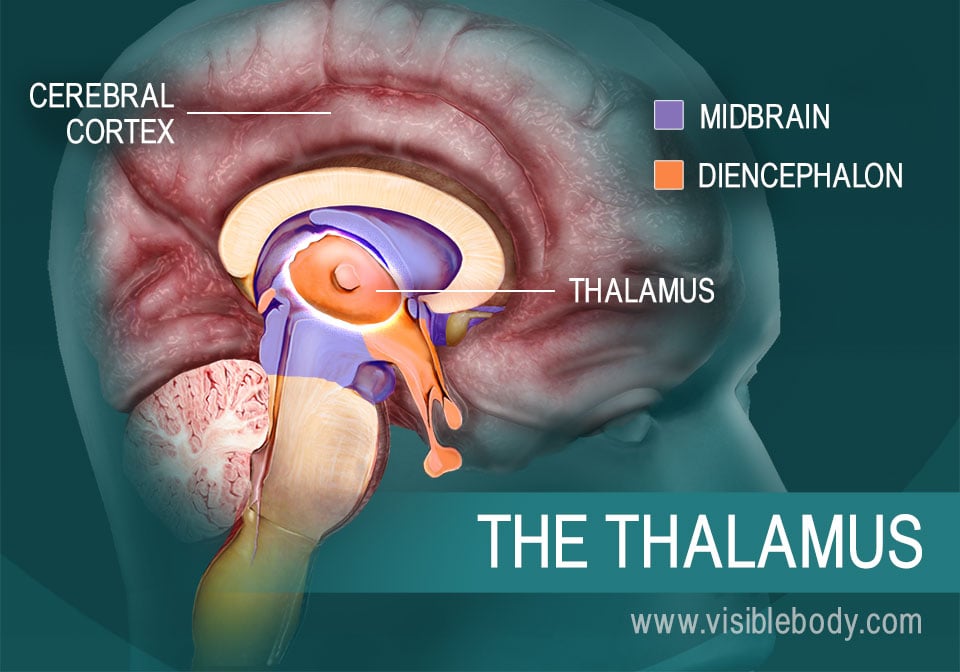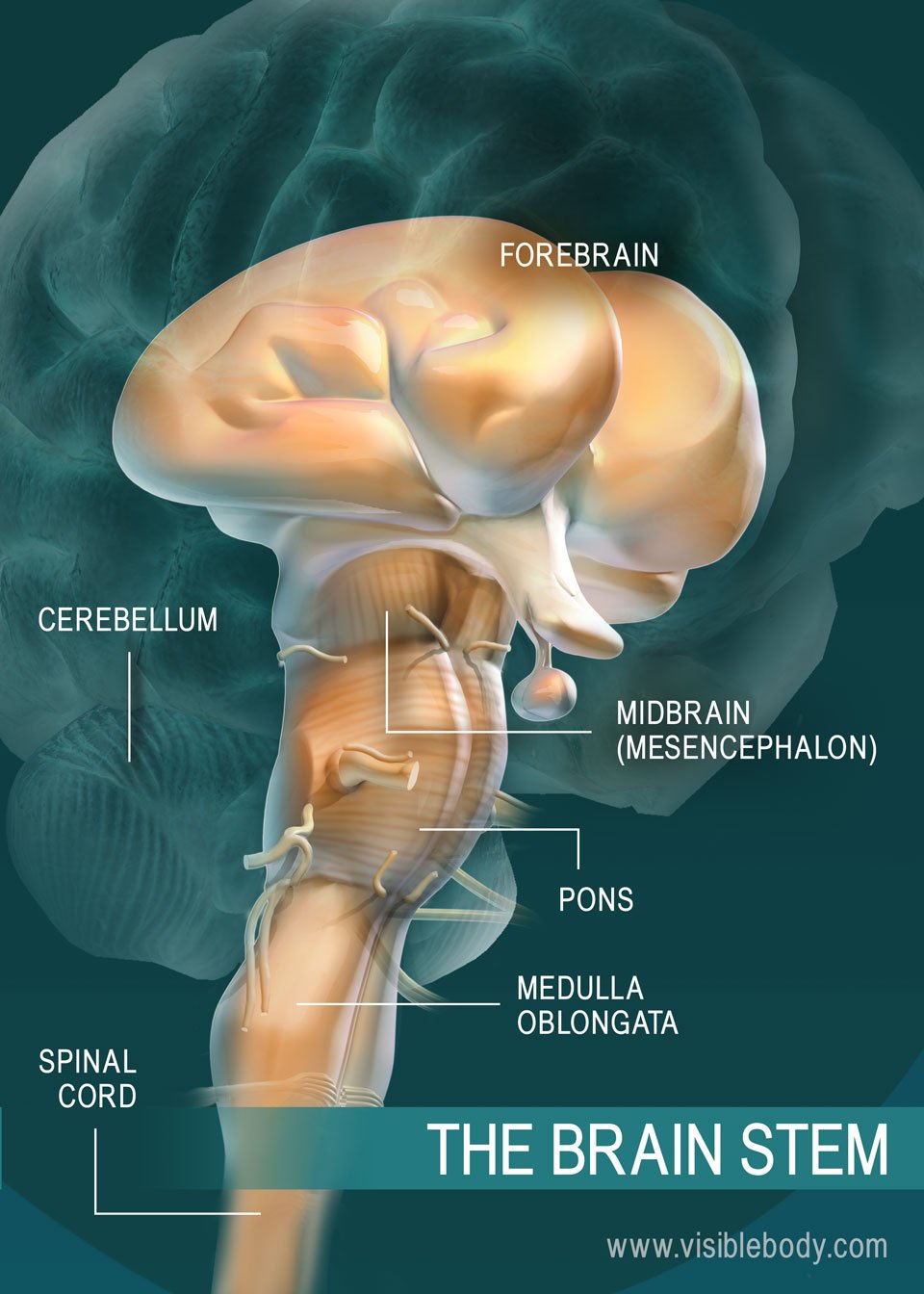Parts of BRAIN: Diencephalon, Brain Stem and Cerebellum and MCQs For NEET, GPAT, Pharmacist, Staff Nurse Exam
The brain is a large organ which lies in the cranial cavity. The average weight of brain is 1.4kg. It is divided in 4 parts: cerebrum, brain stem, diencephalon and cerebellum.
DIENCEPHALON
This part of brain connects the cerebrum to the midbrain. It consist of several structures around the third ventricle; which includes thalamus, hypothalamus. Pineal gland and optic chiasma are also present.
- THALAMUS:- The thalamus consist of two masses of grey matter and white matter within the cerebral hemisphere below the corpus callosum; one on each side of third ventricle. sensory impulses from the skin and viscera, related to pain, touch, temp etc reaches the thalamus for recognition; only basic recognition occurs at thalamus, as for refined perception, other parts of brain are also required. It is also involved in the processing of some emotions and complex reflexes. It relays and redistributes the nerve impulses to most parts of brain and cerebral cortex.

- HYPOTHALAMUS:- it is a small structure of about 7g. it consist of no. of nuclei; it is situated below and in front of the thalamus. The hypothalamus is linked to the posterior lobe of the pituitary gland by the nerve fibers; and to the anterior lobe by the network of blood vessels. Through these connections, it controls the output of the hormones of both the lobes. Functions of hypothalamus include control of:- ANS, body temp, sleeping and walking cycle, sexual behaviour etc.
BRAIN STEM
the brain stem consist of 4 parts:-
- MIDBRAIN:- the midbrain is area of brain which lies around the cerebral aqueduct; between the cerebrum above and the pons below. It consist of nuclei and cerebral tracts. The nuclei acts as relay stations for ascending and descending nerve fibers. It plays important role in auditory and visual reflexes.
- PONS:- it is situated in front of cerebellum, below the midbrain and above medulla oblongata. It mainly consist of nerve fibers that forms a bridge between the two hemispheres of the cerebellum and the fibers passing between the higher levels of brain and spinal cord. The nuclei act as relay stations and some are involved in cranial nerves. It also facilitates the control of respiration along with medulla oblongata.
- MEDULLA OBLONGATA:- It is the interior part of the brain stem, which extends from the pons above and is continuous with the spinal cord below. It is about 2.5cm long and lies above the foramen magnum. Its outer portion is white matter, which passes between the brain and spinal cord; and the central portion contains the grey matter.
The vital centers which consist of group of cell bodies are associated with the autonomic reflexes. These centers are: cardiovascular center, respiratory center, reflex center of vomiting, coughing, sneezing etc. Features of medulla includes:-
- cardiovascular center(CVC)- This area controls rate and force of contraction, blood pressure, diameter of the blood vessels etc. the area receives impulses from baroreceptors, chemoreceptors etc.
- respiratory center- this area controls the rate and depth of respiration. It works in coordination with the pnuemotaxic and apnuestic centers of pons.
- reflex centers- presence of irritants within the digestive and respiratory tract stimulate the reflex centers. these centers than respond in form of vomiting, coughing sneezing etc.
- Reticular Formation:- It is a collection of neurons in the core of brain stem. It has a vast number of synaptic links with other parts of brain and therefor constantly receives information and transmit to ascending and descending tracts. Its functions include:- coordination of skeletal system, control of ANS, it selectively permit the passage of impulses to and from cerebral cortex.

CEREBELLUM
It is situated behind the pons and below the posterior portion of cerebrum. It has two hemispheres which are separated by narrow strip known as vermis. The grey matter forms the surface of cerebellum and white matter lies deeply.
Cerebellum is associated with the voluntary muscle movement, body posture and balance. The cerebral activity is not under voluntary control. sensory input is received from muscles, joints, eyes and ears. The proprioceptor input is derived from the muscles which indicate their position, eyes and semicircular canal provide info about position of head in space. Cerebellum than integrates this info to regulate the skeletal muscle activity. It also facilitates learning and language processing. Damage to cerebellum results in uncoordinated muscle movement which leads to inability to carry out smooth, steady and precise movements.
Multiple choice questions(MCQs)
1. The brain is divided in how many parts?
A. 3 B. 4
C. 5 D. 2
2. What is the function of diencephalon?
A. connects cerebrum and midbrain B. connects cerebrum and cerebellum
C. connect cerebellum and pons D. connect pons and midbrain
3. what is the function of midbrain?
A. visual reflex B. smell reflex
C. auditory reflex D. both A and c
4. Where is the cerebellum located?
A. above the pons B. behind the pons
C. in front of pons D. behind midbrain
5. Match the following-
a. thalamus 1. Located in the interior part of brain stem
b. hypothalamus 2. Lies below midbrain
c. pons 3. Linked with the lobes of pituitary gland
d. medulla oblongata 4. Involved in complex reflexes
6. Which of the following is a feature of medulla oblongata?
A. cardiovascular center B. respiratory centers
C. reflex centers D. all of the above
7. Which part of brain works along with pons for the control of respiration?
A. midbrain B. thalamus
C. medulla oblongata D. hypothalamus
8. Which of the following statement is true?
A. brain is located in the cranial cavity
B. medulla is the superior part of brain stem
c. cerebellum is involved in involuntary control
D. reticular formation is a collection of nerves in the core of brainstem
9. Sensory impulses from skin reaches which part of brain first?
A. thalamus B. hypothalamus
C. pons D. cerebellum
10. Which of the following is a part of diencephalon?
A. pons B. medulla oblongata
C. midbrain D. none of the above
ANSWERS:-
1. 4
2. connects cerebrum and midbrain
3. Both A and C
4. behind the pons
5. a – 4 b – 3 c – 2 d – 1
6. all of the above
7. medulla oblongata
8. brain is located in the cranial cavity
9. thalamus
10. none of the above
Participate in Online FREE GPAT TEST: CLICK HERE
Participate in Online FREE Pharmacist TEST: CLICK HERE
Participate in Online FREE Drug Inspector TEST: CLICK HERE
REFERENCE:
1. Ross and Wilson-Anatomy and physiology in health and illness; 12th edition; page no.-:158-160 .
2. Gerard J. Tortora -Principles of anatomy and physiology; edition twelfth ; page no.-:503-513 .